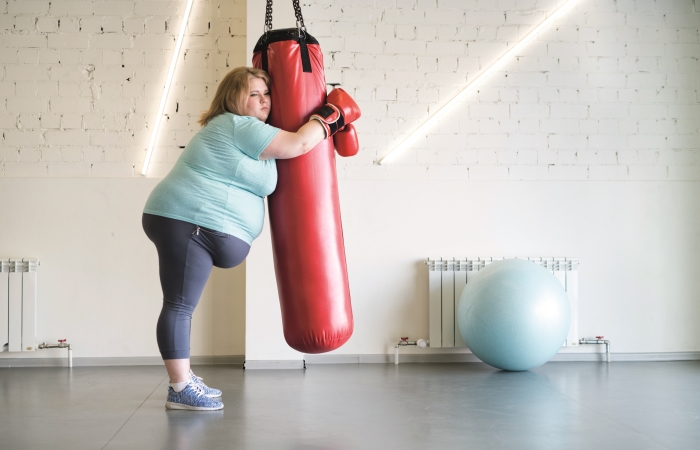A sporting chance
In OTC
Follow this topic
Bookmark
Record learning outcomes
Obesity and overweight statistics are at an all-time high in the UK, with people of all ages putting their health at risk simply by being too heavy. So how can pharmacy help?
Obesity seems to be the health topic of the moment. From too much sugar in our diets to too little activity in our daily lives, we are bombarded with news stories highlighting the unhealthy habits of the nation and how they are putting stress on our bodies as well as the NHS.

Alarming statistics NHS Digital’s recently published Statistics on Obesity, Physical Activity and Diet – England, 2018 report reveals that obesity prevalence has remained at a similar level – around 26 per cent – in the adult population since 2010. Interestingly, in 1993, this figure was just 15 per cent. So although rates haven’t risen much in the last eight years, there are still pressing concerns – and there is a long way to go before we start to see rates falling.
The report shows that people in England are worryingly complacent about their weight. It states, for instance, that during 2016/17:
- In addition to the 26 per cent of the population classified as obese, 40 per cent of men and 30 per cent of women were overweight. This means that overall, more than 60 per cent of the adult population are now either overweight or obese
- There were 617,000 admissions to NHS hospitals where obesity was a factor – an increase of 18 per cent on the previous year
- Only 53 per cent of overweight adults said they were trying to lose weight
- Only 50 per cent of overweight adults thought they were too heavy
- About half of those who were trying to lose weight were not using any weight management aids, such as going to the gym or some other form of exercise, using an activity tracker or fitness monitor, website or mobile phone app or receiving support from an NHS service or slimming club.
Tam Fry, chair of the National Obesity Forum, describes the obesity figures as “appalling”. He is also certain that adult weights have not yet plateaued and will continue to increase. “We shouldn’t be complacent about this at all,” he says. “The problem is that overweight and obese people look around and see that plenty of other people are their size so they think they are OK – we have normalised the condition. This report shows that a high number of people are determined to believe they are not overweight.”
The problem is, says Tam, that there are too few health professionals helping people to lose weight. “There are very few courses run by health professionals dedicated to helping people lose weight because clinical commissioning groups can’t afford to run them and GPs don’t have time to have those conversations with patients during the 10 minute consultation,” he explains, adding that this is where the pharmacy team can play a vital role in stepping into the gap and offering support and advice.
According to the NHS Digital report, more than 400,000 items were prescribed for the treatment of obesity in England alone during 2016/17. These people will be visiting pharmacies to collect their medication, and this will provide many opportunities for pharmacy staff to start conversations with them about their weight and activity levels.

From fat to fit
Another alarming statistic in the report is that only 34 per cent of men and 42 per cent of women meet the Government’s activity guidelines of doing 150 minutes of moderate physical activity each week. In fact, one in five men (21 per cent) and one in four women (25 per cent) were classed as inactive in 2016.
Tam says that this is a real concern because exercise can play a key role in helping people to reach and maintain a healthy weight. “You cannot walk or jog off a bad diet,” he says, “but if you do some form of exercise, you will become healthier and that will work its way through and you will feel better – and that will help you to lose weight as well.”
NICE guidelines on managing obesity recommend that obese adults should be encouraged to increase their level of physical activity, even if they do not lose weight as a result because of the other health benefits it can bring. These include reducing the risk of type 2 diabetes and cardiovascular disease.
Aimee Bishoprick, counter assistant and health champion at Numark’s Marton Pharmacy in Middlesbrough and Healthy Living Advisor winner at the Recognition of Excellence Awards 2017, says she likes to act as a role model to encourage people with concerns about their weight to become more active. “I have one customer who suffers from a low mood and has stopped going out with friends because of her size,” says Aimee. “I do Park Run, which is a free, weekly 5K timed run held in local parks around the country, and have offered to meet her there and walk with her at the back. She hasn’t come yet, but keeps popping into the pharmacy for a chat, so I’m hopeful that she will take the plunge.”
Aimee says that a useful tip is to have a range of displays on the counter about public health issues such as healthy eating or becoming more active, which can be used to start conversations. “Often, overweight and obese people find it hard to become more active because they feel embarrassed about their weight and what they might look like doing exercise,” she says. “But you can start by just planting a thought in their mind and they may eventually act on it or pass the information on to somebody else.”
The NHS Choices website outlines many ways to ‘Get Fit for Free’, and highlights that the secret to getting fit for free is to use every opportunity to be active. This doesn’t have to be running, swimming, brisk walking, gardening and dancing all count too.
Other free ways to boost activity levels include walking everywhere – even a 10 minute walk can make a difference to a person’s health; climbing stairs where possible, which burns more calories than jogging; cycling to work; and exercising at home.
NHS Choices provides links to a range of free activities, such as home workouts, exercise videos for all abilities and a “Couch to 5K” running plan for beginners. It also suggests signposting customers to local authorities, who may have information on leisure centres which offer initiatives such as free exercise classes, a free swim on certain days of the week or outdoor gyms that have equipment that can be used free of charge.
Getting fit safely
Steve Tolan, head of practice and development at the Chartered Society of Physiotherapy, says pharmacy customers should be encouraged to choose activities that they will enjoy, and to build up the amount of activity they do gradually in order to avoid injury.
“It can also be about making small changes in everyday activities,” adds Steve. “For example, getting off the bus a stop earlier, taking the stairs instead of a lift, even if it’s one level. Gradually incorporating these small changes and increasing them as they feel comfortable can make a difference. It’s important though that individuals build up their amount of exercise to ensure they are ultimately meeting the recommended national physical activity guidelines.”
In addition to increasing activity slowly, customers should be advised, when appropriate, to do injury prevention exercises or stretches. They should make sure they listen to their bodies and if they have any niggles, they may need to temporarily modify their exercise until symptoms subside.
The wider benefits
The Government’s physical activity guidelines say that doing some form of exercise every day helps to maintain a healthy weight and reduces the risk of developing a range of diseases, including coronary heart disease, stroke and type 2 diabetes. It also helps people to maintain people’s ability to perform everyday tasks with ease.
Exercise has been shown to play a key role in improving mental health too. A new review, led by UK researchers, suggests that not only could exercise reduce the symptoms of depression, but it may also prevent it.
The review looked 49 studies involving 266,000 people. It found that those who followed the recommended weekly guideline of 150 minutes of moderate aerobic activity were 31 per cent less likely to develop depression over the seven and a half year research period than those who did not achieve this level of activity. The results, published in the American Journal of Psychiatry, applied to men and women, young people, adults and elderly people.
Co-author Dr Brendon Stubbs, a post-doctoral research physiotherapist at the Institute of Psychiatry, Psychology and Neuroscience at King’s College, London, says: “The key message is that when it comes to reducing your chances of developing depression, some physical activity is better than none and the more you do, the better your chances are of preventing depression developing.”
Stephen Buckley, head of information at mental health charity Mind says that exercise can be as effective as antidepressants in treating mild to moderate depression. Additionally, he says that structured physical activity can play a key role in recovery from mental health problems and can help people to stay well for years to come. “Exercise helps use the hormones the body produces under stress,” explains Stephen. “It relaxes muscles, strengthens the heart, improves blood circulation and releases endorphins. This helps to reduce anxiety, lifts a person’s mood and can help them to feel calmer.”
Stephen goes on to say that when fitness levels increase, it can really boost self-esteem. “The sense of achievement a person gets from learning new skills can help them to feel better about themselves,” he says. “Improved self-esteem also has a protective effect that increases life satisfaction and can make people more resilient and less stressed.
Group exercise can also be beneficial, believes Stephen. “Exercising in a group setting can help to combat feelings of hopelessness, loneliness and isolation,” he says. “It provides an opportunity to strengthen social networks, talk through problems with others or simply laugh and enjoy a break from family and work.”
Common sports injuries

Sprains and strains
Sprains and strains are common injuries that affect the muscles and ligaments. Initially, they should be treated with an ice pack for 72 hours to help reduce swelling and inflammation. Cold products in the form of sprays, patches and gels can also be applied during the first 72 hours. The affected area should also be rested. If the injury is painful, paracetamol can be taken at any time, in line with pack instructions. However, ibuprofen should not be used until 48 hours after the injury has occurred as it may slow down healing. Similarly, heat products should not be used during this time or while swelling is present as they stimulate blood flow to the area.
Sprains and strains can be prevented by warming up properly before exercising and not exercising when muscles are tired. Heat products can be recommended for use before exercise to help warm up muscles.
Blisters
Blisters should heal on their own within a week, but refer customers to the pharmacist if they have a blister that looks infected or is in an unusual place, if the blisters is associated with sunburn, the blister is very painful or keeps coming back, or if several blisters have appeared for no reason.
For blisters caused by friction (e.g. from footwear or repetitive sports), the following advice will help: customers should wash their hands before touching the blister to prevent infection; they should cover a blister that is likely to burst with a soft plaster or dressing, but they should allow the fl uid in a burst blister to drain before covering it with a plaster. Special hydrocolloid blister plasters can help to reduce pain and speed up healing. Wearing comfortable shoes that fi t well and thicker socks during exercise can help to prevent blisters from occurring.
Athlete’s foot
Athlete’s foot is a common fungal infection. It thrives in warm, moist environments and can be picked up from changing room floors. Symptoms include itchy white patches between the toes; red, sore, fl aky patches on the feet, and skin that may crack and bleed.
Pharmacy staff can recommend athlete’s foot treatments that contain antifungal medicines, which are available as creams or sprays. Customers should also be advised to make sure their feet are completely dry after bathing or showering, wear clean cotton socks every day, use a separate towel for drying their feet and take their shoes off when they are at home.
Verrucas
Verrucas can be caught from wet floors in changing rooms and swimming pools. They are caused by a virus and can appear as small lumps of skin growing up into the soles of the feet. They are likely to have black dots in the centre surrounded by a harder, white area. Verrucas can be treated with over-the-counter creams, plasters and sprays. Advise customers to wash their hands before and after touching a verruca or applying treatment, to change their socks daily and to cover the verruca with a plaster. Wearing flip-flops in areas where verrucas might be picked up is also good practice.
More than 60 per cent of the adult population are now either overweight or obese
